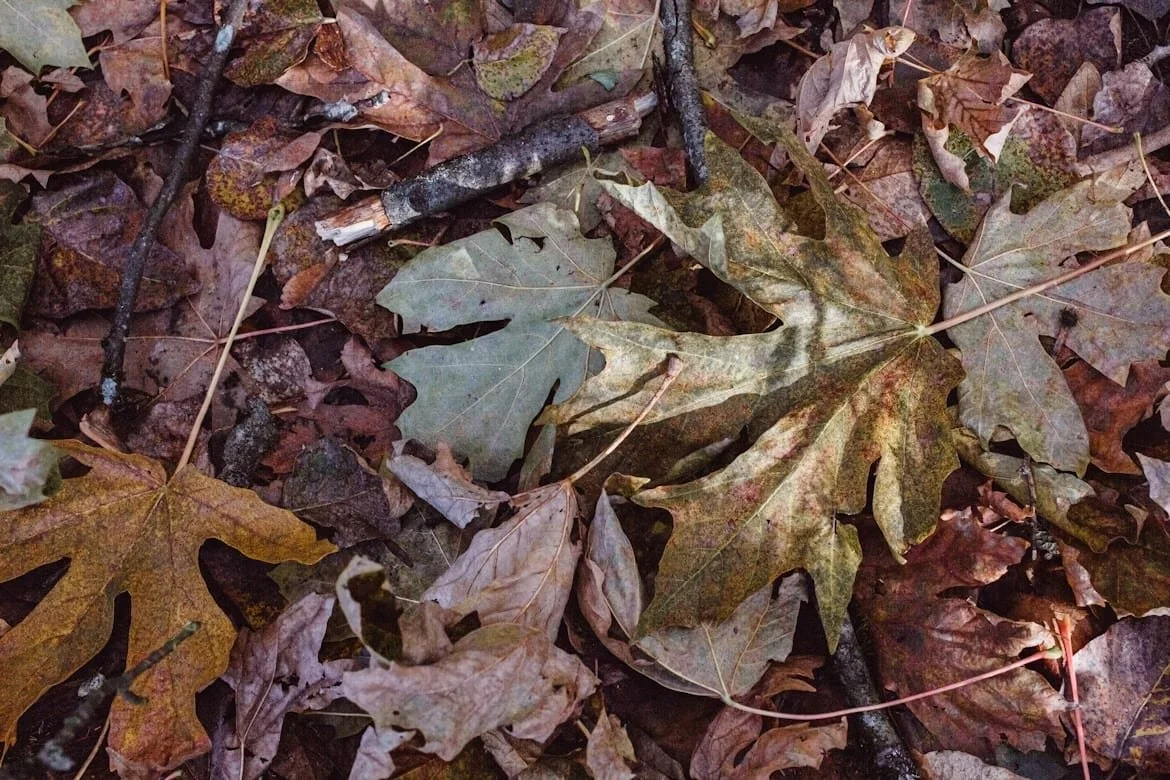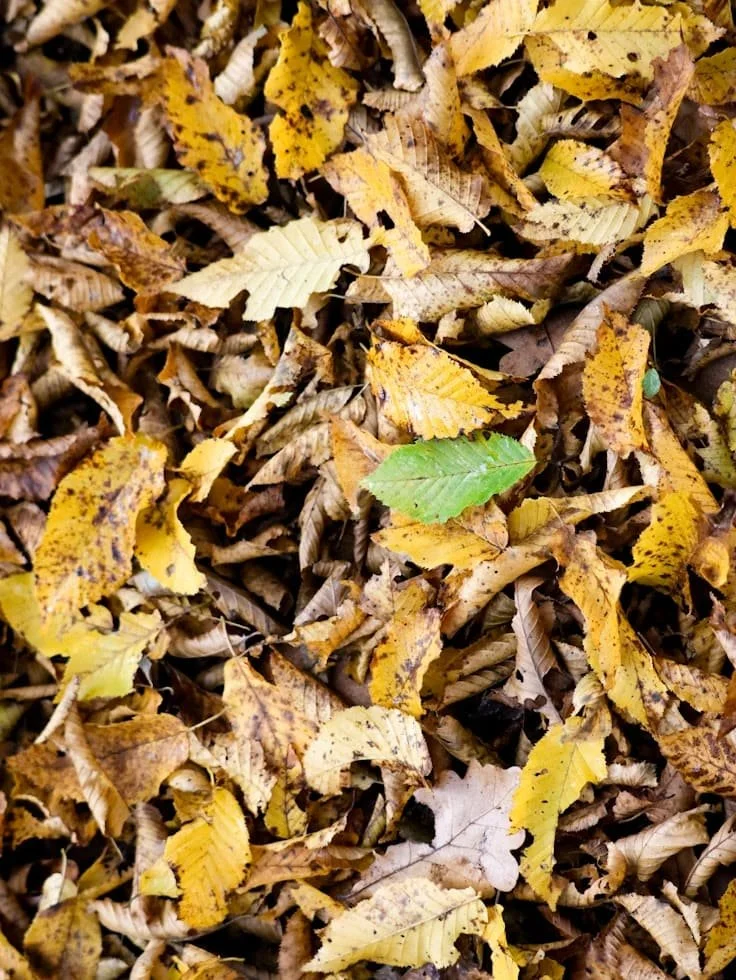Leaf Management for Soil Health and Habitat
Dear Friend,
Here in the mountains, October is the season when the trees start to write their annual letters to the earth — in golds, reds, and russets. The first frosts set the message in motion, and before long the air smells of tannins and woodsmoke. The ground begins to soften under a quilt of leaves, and the whole forest changes its sound — quieter, muffled, except for the satisfying crunch under your boots.
For many gardeners, falling leaves signal “cleanup time.” Out come the rakes, the blowers, the tarps. Leaves are gathered and carted away like unwanted debris. But here’s the truth: those leaves are not trash. They’re an asset. A resource. A gift.
If you understand how to manage them well, leaves can be the cornerstone of a healthier garden ecosystem — improving your soil, feeding beneficial organisms, and creating critical overwintering habitat for wildlife. Today, I want to share with you the science, the practice, and the traditions behind leaf management.
Why Leaves Matter
From a soil chemistry perspective, leaves are a natural slow-release fertilizer and mulch. Most hardwood leaves have a carbon-to-nitrogen ratio around 40–80:1 — high enough to decompose slowly, but low enough to contribute nutrients without tying up nitrogen for long periods.
As they break down, leaves:
Add organic matter to the soil, improving tilth (structure, porosity, and water-holding capacity).
Feed soil microorganisms, especially fungi, which are the backbone of healthy perennial systems.
Return essential minerals such as calcium, potassium, and magnesium — drawn up by the tree’s roots over decades.
In the forest, leaf litter is the primary source of humus. It’s why undisturbed woodland soil is dark, spongy, and teeming with life. In our gardens, we can mimic that process — just guided, controlled, and placed where it benefits our chosen plants most.
Leaf Litter as Habitat
Beyond the soil benefits, leaves are shelter for an entire community of creatures:
Butterflies & moths — Many species, including luna moths and swallowtails, overwinter as pupae in the leaf litter.
Native bees — Ground-nesting species use leaf cover as insulation against frost.
Amphibians & reptiles — Toads, salamanders, and box turtles use leaf piles to regulate temperature and moisture.
Birds — Leaf litter harbors insects and larvae, which become vital winter and early-spring food for species like Carolina wrens and eastern towhees.
The ecological case is clear: the more leaf litter you can keep on-site, the more life your garden can support through the cold season.
Practical Leaf Management Strategies
Now, not all leaves can stay exactly where they fall. On turf areas, a thick mat can smother grass; in certain ornamental beds, they can harbor fungal diseases if not managed. Here’s how to balance ecological benefit with horticultural practicality:
1. Leave the Leaves (In the Right Places)
Ideal for: Naturalized areas, under shrubs, in perennial beds, woodland gardens.
Depth: 2–4 inches is optimal; too deep and air circulation suffers.
Timing: Spread leaves evenly in fall and allow them to break down over winter.
Tip: Chop large, leathery leaves (like oak or magnolia) with a mower to speed decomposition and prevent matting.
2. Mulch Mowing for Turf Health
Ideal for: Lawns, mixed-use turf areas.
Method: Use a mulching mower to shred leaves directly into the grass.
Benefits: Shredded leaves decompose quickly, returning nutrients to the soil without harming turf growth. Research from Michigan State University shows this can reduce dandelion and crabgrass pressure by improving soil fertility.
3. Composting for Controlled Breakdown
Ideal for: Surplus leaves from high-shed areas.
Carbon Source: Leaves are high-carbon material; balance with nitrogen-rich inputs like grass clippings, vegetable scraps, or manure at a 30:1 C:N ratio.
Moisture: Keep piles as damp as a wrung-out sponge.
Aeration: Turn every 4–6 weeks to accelerate breakdown.
4. Leaf Mold Production
Ideal for: Low-maintenance soil amendment creation.
Method: Pile leaves in a shaded, moist corner 3–4 feet high; keep slightly damp.
Timeframe: 12–18 months for full breakdown into dark, crumbly humus.
Uses: Topdressing for perennials, soil conditioner for vegetable beds, potting mix ingredient.
Managing Diseased Leaves
Some leaves — notably from plants infected with fungal pathogens like powdery mildew, rust, or tar spot — are better removed from the immediate garden environment. Options:
Hot composting (above 140°F for 3+ days) to kill spores.
Municipal yard waste programs that guarantee high-heat processing.
Never leave diseased leaves in place under susceptible plants; it can increase disease carryover into the next season.
Leaf Management for Client Landscapes
For Unicorn Farm’s landscaping clients, we often tailor a hybrid approach:
Mulch mow turf areas weekly during peak leaf fall.
Rake and redistribute excess leaves into shrub and perennial beds.
Create “wild zones” where leaf piles are intentionally left for habitat.
Remove only diseased or obstructive leaves (drains, walkways).
This method keeps properties tidy enough to meet client expectations while still honoring the ecological value of leaves.
A Seasonal Timeline
Mid-October to Early November: Begin mulch mowing turf; redistribute leaves to beds.
Late November: Collect and stockpile surplus leaves for compost or leaf mold.
Winter: Allow leaves in naturalized areas to settle; monitor for wind-blown drift onto lawns.
Early Spring: Rake back leaf mulch from emerging bulbs and early perennials, leaving a thin layer for moisture retention.
The Bigger Picture
Leaf management is one of those garden tasks where science and tradition shake hands. The Appalachian way — don’t waste what the land gives you — aligns perfectly with ecological landscaping principles. By keeping leaves on-site in a managed way, we:
Reduce the need for synthetic fertilizers.
Improve soil structure and moisture retention.
Provide habitat for countless species.
Reduce municipal yard waste and the carbon footprint of hauling.
Closing Thoughts
When you look at a pile of autumn leaves this year, try to see them for what they truly are: a nutrient bank, a shelter, a bridge between seasons. Yes, they may need a bit of moving, shredding, or composting to fit into your garden’s plan — but they are far from waste.
In the end, the leaves that fall on your land are part of its story. How you handle them determines whether that story continues underground, feeding the soil and the life it holds, or whether it’s cut short and carted away.
I hope you’ll choose to let those pages keep turning right here at home.
Yours in the turning of the seasons,
Unicorn Farm Nursery & Landscaping

